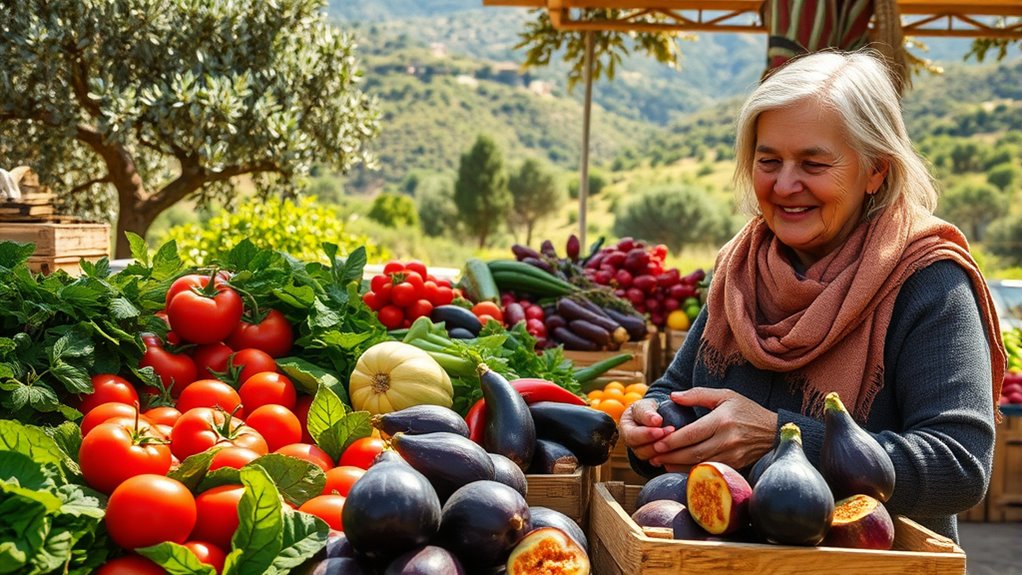The Blue Zones diet teaches you to focus on mostly plant-based foods like vegetables, fruits, whole grains, and legumes, which support longevity. Incorporate healthy fats from nuts, seeds, and olive oil, and practice mindful eating by controlling portions and eating slowly. Sharing meals with family and staying active through simple daily movements are key. To learn how these habits combine to promote long, healthy lives, discover how tradition and community shape these vibrant lifestyles.
Key Takeaways
- Emphasize plant-based foods like vegetables, fruits, whole grains, and legumes as the foundation for longevity.
- Incorporate healthy fats from nuts, seeds, olive oil, and avocados to support heart and brain health.
- Practice mindful eating, portion control, and traditional cooking methods to preserve nutrients and prevent overeating.
- Foster social connections through shared meals and community, which enhance psychological well-being.
- Maintain active lifestyles with daily movement, outdoor activities, and physical chores to promote overall health.
The Key Principles of Blue Zones Eating Patterns
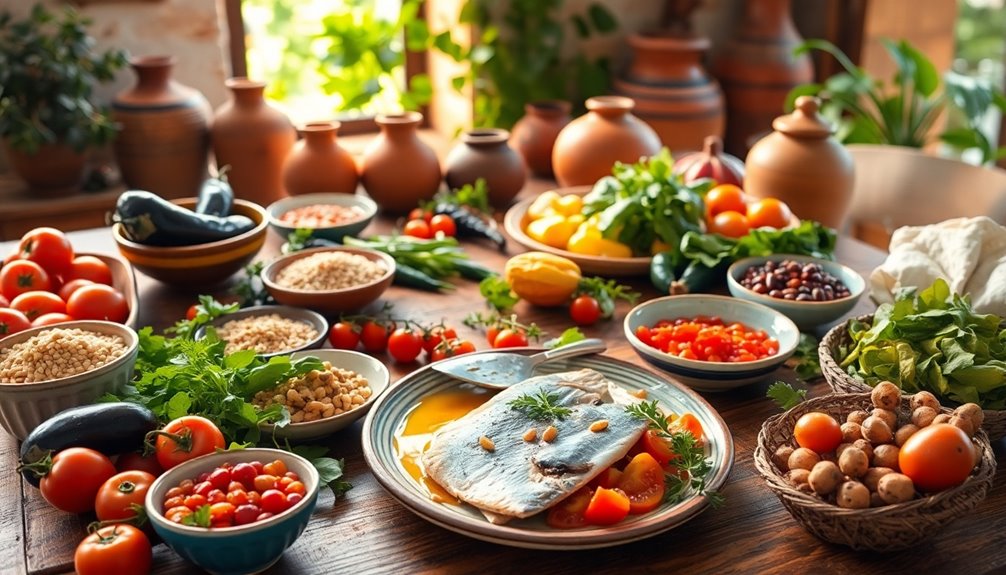
The key principles of Blue Zones eating patterns focus on simple, nutrient-dense foods and mindful habits that promote longevity. You’ll primarily eat fruits and vegetables, which supply antioxidants and fiber, alongside whole grains that provide sustained energy. Beans and legumes are staples, offering rich protein and minerals, while nuts and seeds deliver healthy fats and nutrients. Instead of salt and sugar, herbs and spices add flavor, encouraging healthier cooking. Meat is eaten sparingly, with fish often serving as the main protein source, especially in Okinawa. Dairy and eggs are limited, and added sugars are kept minimal. These habits emphasize eating until satisfied, slowing down meals, and avoiding distractions. Such mindful practices foster better digestion, reduce overeating, and support a balanced, healthful diet aimed at long life. Additionally, cultivating a positive mindset and engaging in regular physical activity complement these dietary choices to enhance overall well-being. Incorporating mindful eating techniques can further improve digestion and prevent overeating, reinforcing the longevity benefits of this diet. Recognizing the importance of nutrient-dense foods helps emphasize quality over quantity in daily meals. Understanding the food environment and how it influences choices can lead to more consistent healthy eating habits. Moreover, being aware of portion sizes can help prevent overconsumption and support calorie moderation for better health outcomes.
Emphasizing Plant-Based Foods for Longevity
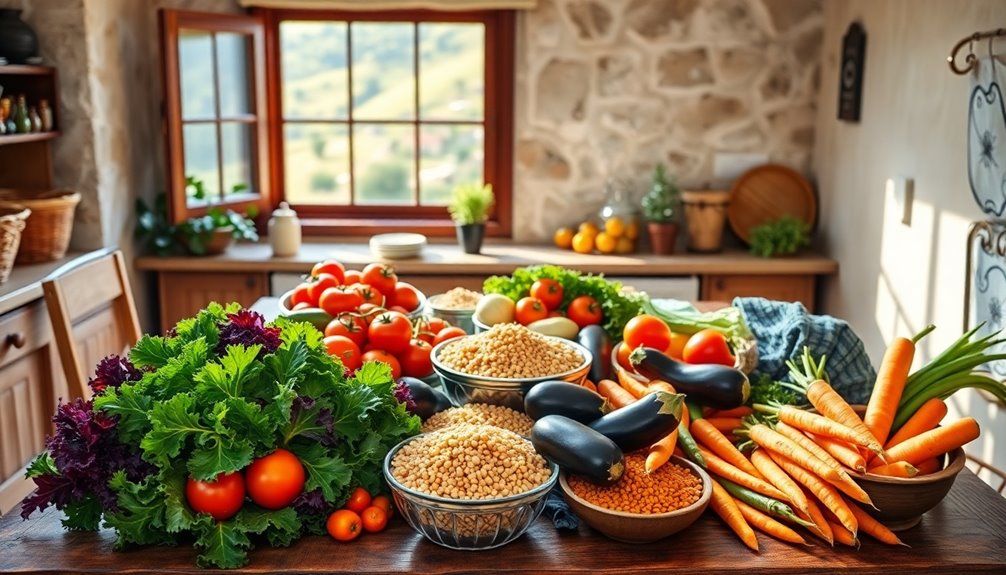
Emphasizing plant-based foods plays a crucial role in promoting longevity within Blue Zones communities. About 95% of centenarians in these areas mainly eat plant-based diets, with daily meals centered on leafy greens like spinach, kale, and chard. Seasonal fruits, vegetables, whole grains, and beans are staples year-round, providing essential nutrients, fiber, antioxidants, and phytochemicals. Incorporating healthy fats from plant sources further supports cardiovascular health. Plant-derived oils replace animal fats, supporting heart health and reducing inflammation. This diet’s richness in nutrients helps lower chronic disease risks and enhances cellular repair. Additionally, many Blue Zones residents utilize electric bikes for transportation, promoting physical activity and outdoor engagement. The focus on simple, culturally ingrained plant foods encourages sustainable eating habits. Consuming a variety of nutrient-dense foods ensures optimal health and longevity. A balanced intake of macro- and micronutrients, emphasizing dietary diversity, is vital for maintaining health over the lifespan. By emphasizing nutritional quality, communities can maximize health benefits and longevity. When combined with active lifestyles and social engagement, your diet can considerably boost longevity, as evidenced by communities that regularly enjoy higher life expectancies than the average.
The Role of Legumes and Whole Grains in Health
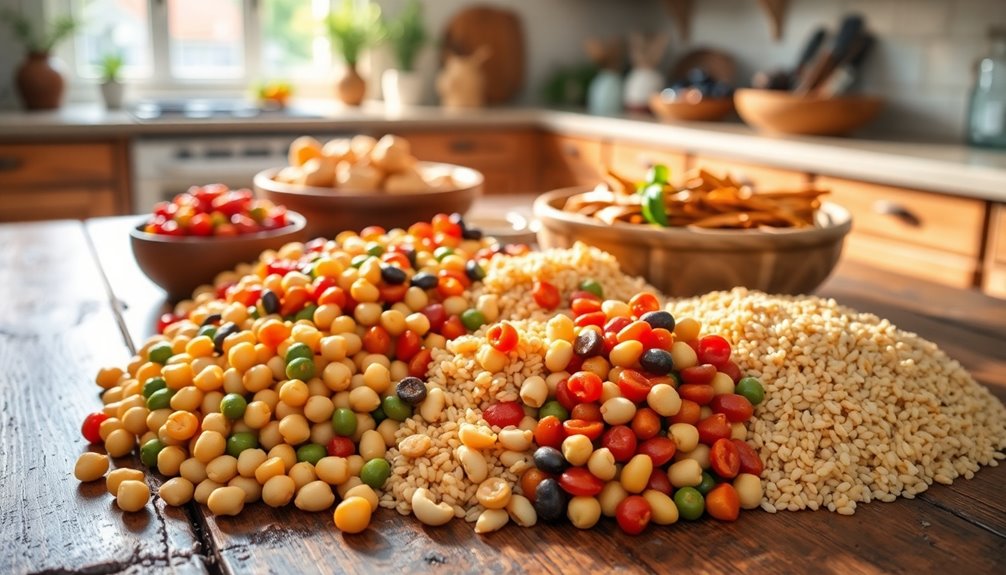
Legumes and whole grains are essential components of a healthful diet, especially in Blue Zones communities where longevity is prominent. They provide high-quality plant-based protein that supports muscle maintenance and repair, while their rich fiber content promotes digestive health and helps control blood sugar. These foods are packed with crucial micronutrients like iron, zinc, magnesium, and B vitamins, which boost overall health. Their low fat and calorie levels aid weight management and reduce obesity risk. Both legumes and whole grains contain bioactive compounds with antioxidant and anti-inflammatory properties, helping protect against chronic diseases. Regularly including these foods in your diet can lower blood pressure, improve cholesterol levels, enhance metabolic health, and contribute to a longer, healthier life—key reasons they’re staples in Blue Zones diets.
Mindful Meal Timing and Portion Control
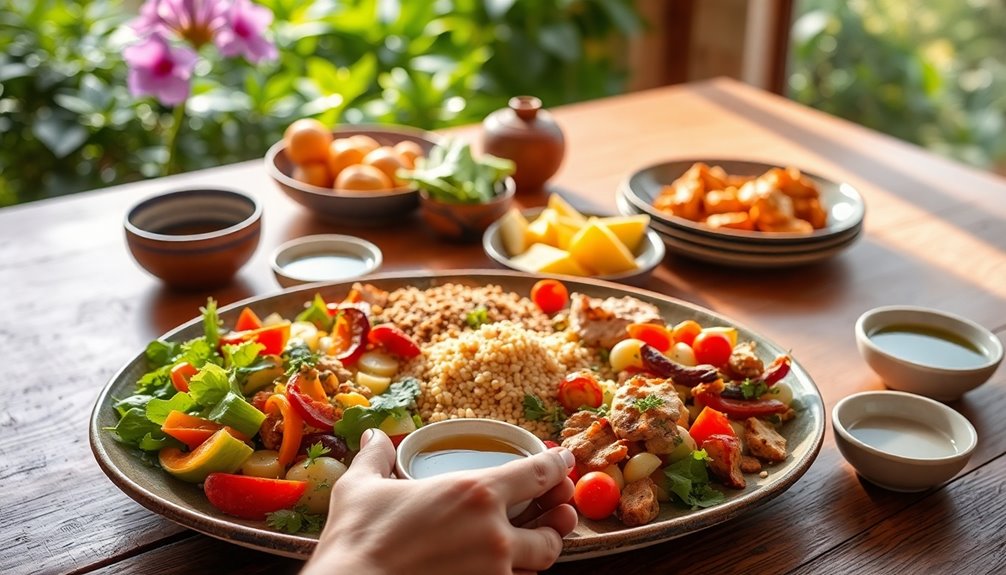
Practicing mindful meal timing and portion control can substantially enhance your overall health and support longevity. Focus on eating larger, hearty meals earlier in the day, like breakfast and lunch, and keep dinner lighter to improve digestion overnight. Savor each bite slowly, chewing thoroughly, and avoid distractions like screens to truly enjoy your food. Use the 80% full rule—stop eating before you feel completely full—to prevent overeating. Regular routines help your body adapt, so aim for consistent meal times. Skip late-night snacks and listen to your hunger cues, adjusting portion sizes accordingly. Sharing meals with loved ones and respecting food’s value foster mindful habits. Embracing these practices aligns with Blue Zones principles, promoting a healthier, longer life. Incorporating mindful eating strategies can further optimize your meal planning and health outcomes. Additionally, understanding the importance of diversification of your diet can help ensure you receive a broad spectrum of nutrients, further supporting longevity and overall well-being. Engaging in sleep hygiene practices, such as maintaining a consistent sleep schedule, can also positively influence your digestion and overall health. Incorporating a variety of low-light office plants into your environment may also positively influence your mood and reduce stress, complementing your health efforts.
Incorporating Nuts and Healthy Fats Into Daily Life

Adding nuts and healthy fats to your daily routine complements mindful eating habits and supports long-term health. Incorporate a handful of mixed nuts—almonds, pistachios, walnuts, or Brazil nuts—into your breakfast or snacks. Nut butters spread on toast or fruit make easy, nutritious options. Toss nuts into salads for added crunch and flavor or sprinkle them onto oatmeal and yogurt. Use extra-virgin olive oil in cooking or as a finishing touch for salads and vegetables. Avocados add healthy fats to sandwiches, smoothies, or salads. Flaxseeds and chia seeds boost omega-3 intake when added to cereals or blended into smoothies. These fats help reduce inflammation, support heart and brain health, and keep you feeling full longer, contributing to a balanced, nutrient-rich diet.
Limiting Red Meat and Processed Foods

Limiting red meat and processed foods is a key aspect of the Blue Zones diet, emphasizing a shift toward more plant-based eating habits. Residents typically eat less than two ounces of red meat about five times a month, mainly consuming pork and goat occasionally. The diet centers on plant foods—fruits, vegetables, and whole grains—minimizing meat intake compared to global averages. Processed foods are largely avoided, replaced with unprocessed, seasonal, and natural ingredients that support health and nutrition. This approach results in a diet rich in fiber and nutrients, which promotes longevity and reduces chronic disease risk. While some regions like Hong Kong have higher meat consumption, overall, Blue Zones prioritize whole, minimally processed foods, creating a sustainable and healthful eating pattern that’s proven to support long, healthy lives. Additionally, nutritional diversity in these diets encourages a broad intake of micronutrients essential for maintaining health and vitality throughout life. Incorporating a variety of plant-based foods also enhances dietary sustainability, making it easier to maintain healthy habits over time. Emphasizing herbal teas and other natural beverages can further support hydration and overall well-being within these dietary practices. Furthermore, cultural food traditions often promote the use of local, seasonal ingredients that align with sustainable eating principles, reinforcing the benefits of traditional diets. Moreover, choosing aesthetic hooks and wall organization stylish solutions can create a more inviting and organized space to prepare and enjoy healthy meals.
The Cultural Significance of Social and Family Meals
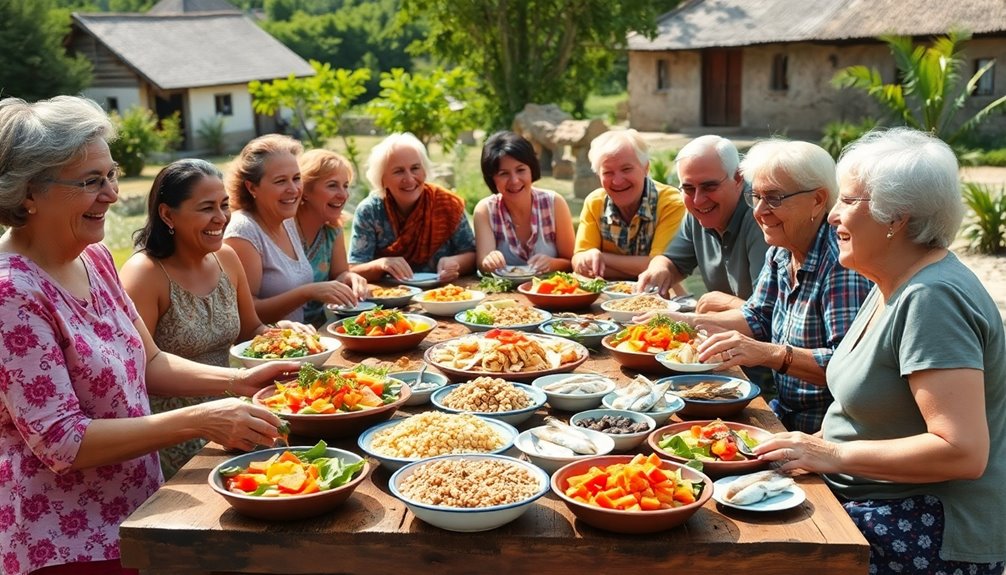
In Blue Zones, communal eating plays a vital role in fostering a strong sense of community and belonging. Sharing meals strengthens social bonds, boosts psychological well-being, and supports longevity. These gatherings are more than just eating; they reinforce cultural identity and pass down traditions across generations. Meals are typically slower and mindful, aiding digestion and satisfaction. Participating in regular family and community meals reduces feelings of isolation and promotes emotional health, which correlates with lower risks of chronic diseases. Traditional meal times, often in the late afternoon or early evening, foster routine and discipline. Meals often feature plant-based, seasonal ingredients prepared by older community members, preserving culinary heritage. This cultural practice creates a supportive environment essential for long-lasting health and social cohesion. Incorporating social and family meals into daily routines can further enhance overall well-being and community resilience. Additionally, the use of wicks and molds in candle making exemplifies how traditional craftsmanship can be preserved and adapted for modern creative pursuits.
Furthermore, observing traditional food preservation methods helps maintain nutritional value and cultural continuity, strengthening community bonds.
Active Lifestyles Complementing Dietary Habits

In Blue Zones, active lifestyles seamlessly support dietary habits, ensuring that physical movement becomes a natural part of everyday life. You’ll find activities like gardening, walking, and household chores woven into daily routines, not as formal workouts but as essential tasks. Living in environments that promote outdoor activity—such as gardens or slopes—encourages consistent movement. Simple choices, like taking stairs or walking further, help reduce sedentary behavior. Engaging in these daily tasks not only keeps you active but also lowers stress and inflammation. Studies show that habitual activity, like walking long distances, extends lifespan and reduces disease risk. In these communities, physical activity is integrated effortlessly, making healthful movement a lifelong habit that complements their nutritious diets perfectly.
Sourcing and Preparing Whole, Unprocessed Foods

In Blue Zones communities, sourcing and preparing whole, unprocessed foods is a shared cultural practice that reinforces their commitment to healthful living. You’ll notice a focus on plant-based diets, emphasizing fruits, vegetables, legumes, nuts, and whole grains. They prioritize seasonal, local produce, supporting sustainability and freshness while avoiding processed foods. When preparing meals, simple methods like boiling or steaming preserve nutrients, and fermented foods boost gut health. Meat is rarely the main dish; instead, it’s a small addition or condiment. Legumes and whole grains are staples, providing fiber and nutrients. This approach guarantees a high intake of antioxidants, phytonutrients, and fiber, promoting longevity and overall health while fostering community bonds through shared food preparation.
Practical Tips to Adopt Blue Zones Eating Habits

To effectively adopt Blue Zones eating habits, start by integrating key foods like legumes, whole grains, fruits, and vegetables into your daily meals. Incorporate beans, lentils, and peas for protein and fiber, and choose whole grains such as brown rice, quinoa, and oatmeal regularly. Fill your plate with a colorful variety of fruits and vegetables to boost nutrients and antioxidants. Use healthy fats from olive oil, nuts, and avocados to enhance flavor and health benefits. Limit meat to special occasions or avoid it altogether, focusing on plant-based meals that make up 95-100% of your diet. Cook at home using traditional recipes and slow cooking methods, which preserve nutrients. Practice portion control, eat mindfully, and stop eating when satisfied to prevent overeating.
Frequently Asked Questions
How Do Blue Zones Populations Maintain Social Bonds Around Food?
You maintain social bonds around food by sharing daily meals with family and friends, creating traditions that bring everyone together. Participating in communal cooking, celebrating seasonal foods, and practicing gratitude strengthen your connections. Involving elders and children fosters intergenerational relationships. Engaging in group activities like gardening or walking before meals adds joy and purpose. These practices encourage conversation, support, and a sense of community, making food a central part of your social life.
What Are Simple Ways to Incorporate More Legumes Into Everyday Meals?
Did you know that eating just 20 grams of legumes daily can reduce your risk of death by about 6%? To incorporate more legumes into your meals, try adding beans or lentils to breakfast omelets, soups, or salads. You can also make hummus for snacks or include chickpea flour in baked goods. Batch cook and freeze legumes to save time, and spice them up with herbs for extra flavor.
How Does Meal Timing Influence Longevity in Blue Zones?
Your meal timing influences longevity by aligning with your body’s natural rhythms, which supports metabolic health and reduces disease risk. Eating earlier in the day, like dinner around 6 p.m., helps regulate blood sugar and hormones, while fasting for 17–18 hours overnight boosts cellular repair. This pattern encourages moderate eating, prevents overeating late at night, and promotes a healthy weight, all contributing to a longer, healthier life.
Can Traditional Blue Zones Diets Be Adapted to Urban or Western Lifestyles?
Ever wondered if old traditions can fit into modern city living? Yes, you can adapt Blue Zones diets to urban or Western lifestyles, but it takes effort. Focus on incorporating more plant-based foods, practice portion control like the 80% rule, and embrace social meals. Cities can support this shift by improving food access, subsidizing healthy options, and encouraging active lifestyles. With intentional changes, longevity benefits are within reach.
What Are the Environmental Benefits of Eating Whole, Local Foods in Blue Zones?
Eating whole, local foods offers significant environmental benefits. You reduce your carbon footprint by supporting regional agriculture and cutting transportation emissions. Choosing locally grown produce minimizes fossil fuel use and helps sustain local economies. Additionally, mindful eating and smaller portions prevent food waste, reducing landfill methane emissions. By focusing on plant-based, minimally processed foods, you also decrease reliance on industrial agriculture, protecting ecosystems, conserving resources, and promoting overall environmental health.
Conclusion
By embracing Blue Zones eating habits, you can boost your longevity and well-being. Imagine adding just a handful of nuts daily—research shows it can reduce heart disease risk by up to 30%. Incorporate more plant-based foods, practice mindful eating, and stay active. Small changes like these could help you join the world’s longest-lived communities, where people often live well into their 90s and beyond, thriving with vigor and purpose.
